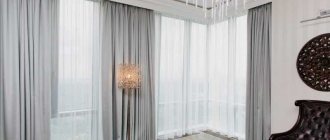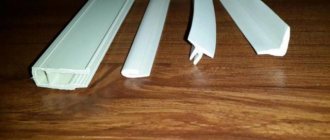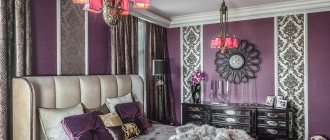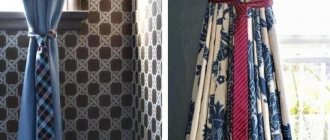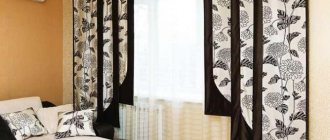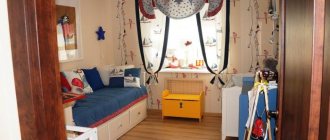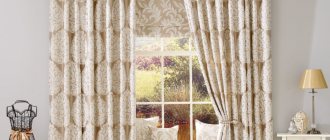Textiles can greatly enhance the style of any room. Curtains have become an integral part of the interior.
They can be dense, heavy, draw attention to themselves, or they can create the effect of lightness and weightlessness. Draping curtains turns a simple fabric into an unusual product.
A purchased ready-made version of the curtain may turn out to be completely inappropriate in the existing room.
In this case, draping curtains with your own hands can correct the situation. You will need very little for this:
- curtain fabric;
- threads, curtain tape;
- decorative elements (cords, tassels, beads).
Interesting ideas for decorating windows with curtains
Multilayer curtains and the use of all kinds of decorations in the form of original bows, tassels, and holders are in fashion. Among the prints, floral patterns occupy the first place. It is relevant to use ruffles as edging. This can be braid, lace, satin ribbons or fringe.
Following simple rules for designing window space helps preserve geometry and brings coziness and comfort to your home. There are many types of curtains, let's look at the most popular options.
Brown blinds for window decoration
Window decoration with thick gray curtains
Window decoration with beige curtains and lambrequins in the dining room
Classic straight models
They are found in most interiors, as they look organically in almost any style direction. Thick fabrics are often combined with sheer, lightweight curtains to create extra volume. Classic products look elegant and sophisticated.
Window decorated with stained glass
Decorating a large arched window with curtains
Yellow printed curtains in the living room
French curtains
They consist of several canvases, each of which falls down in lush folds. They look expensive and luxurious. To create such products, light, noble fabrics are used: muslin, silk, tulle, satin and others. French curtains are suitable for classic, vintage and bohemian styles and will look harmonious in spacious rooms.
Tulle with embroidery and satin curtains in the bedroom interior
White tulle and cream curtains for window decoration
Window decoration with flowers
Combination ideas in the interior of rooms
When creating a design, special attention should be paid to curtains, because they are one of the most important decorative elements of the interior.
Living room or hall
Here you can use both light and darker or contrasting shades. Two-color curtains will add solemnity and elegance to the living room.
The photo shows two-color curtains in the interior of a spacious hall.
Kitchen
More minimalistic options with the absence of unnecessary decor are suitable. An excellent option would be Roman blinds with piping or roller blinds. For narrow kitchens, two-color curtains with horizontal stripes would be appropriate.
The photo shows a bright kitchen with large windows decorated with two-tone Roman blinds with tassels.
Bedroom
It is better to combine curtains in pastel colors with the main color of textiles, which will add completeness to the bedroom interior. Night curtains in this color composition will create a relaxing and calm atmosphere in the room.
Hallway and corridor
Two-color curtains allow you to increase the aesthetic level of the hallway and create an original design in it.
The photo shows two-color curtains in the hallway interior.
Children's
Both contrasting colors and more harmonious combinations will look great in a children's room. In any case, two-color curtains will become a bright and original accent in the room and support the overall style of the room.
Austrian curtains
They successfully combine the pomp of French models and the simplicity of Roman mechanisms. Folds in the fabric appear only when pulled together; in the lowered position, the curtains are straight and smooth. Almost any fabric can be used, but preference is given to airy materials. Austrian models can be hung in the bedroom, hall or living room.
The products look harmonious in classic interiors. When the length is below the window sill, the curtain will completely cover the window, and luxurious festoons will form below.
Shortened views
The most popular are several types of short curtains: Roman, English, Austrian, French and Swedish (roller).
The most common are Roman blinds, which are thick, beautiful curtains in the form of rising “screens.” They vary in texture, materials, and color spectrum, which makes them desirable both in a minimalist setting and in a classic, Provence, high-tech, and loft setting.
The list of suitable rooms is also extensive, for example, wide curtains are perfect for the living room, and narrow curtains that fit tightly to the glass are perfect for the kitchen.
The English model is similar to the Italian one, but differs in the absence of slats, which makes the hem more graceful and airy. Instead of a lifting mechanism, you can choose a lightweight option with long flowing satin ribbons decorated with bows. These curtains are perfect for a shabby chic style bedroom, nursery or kitchen.
Austrian curtains are similar to the previous ones, but have more compartments, lush gathers and folds. The material chosen is translucent thin fabrics in pastel shades of a warm spectrum, which makes them the best solution for girls' rooms.
French-style curtains are an ideal option for a classic living room, where many folds are distributed along the entire length of the material. A weightless cloud on the window will also decorate a light cream kitchen or white bedroom.
Roller models have a more rustic appearance, so Swedish curtains are often purchased for Provence kitchens, as well as loggias, verandas and children's rooms. They are easy to raise and lower, and a wide range of colors and prints allow you to choose the perfect option.
An interesting choice could be cafe curtains, where a simple curtain is attached in the middle of the window, and two short curtains are moved to the sides. In retro and country style kitchens, such curtains up to the window sill are indispensable. Another “plus” of this design is the ability to quickly and easily create a cafe at home yourself.
Each of the considered types can be harmoniously combined with long draperies on the sides, while materials and colors should be as contrasting as possible, and decorative elements should be kept to a minimum.
Roman models
They are in high demand among consumers because they are an alternative to both blinds and classic curtains. Products are made from dense materials, which are assembled into neat folds using a lifting mechanism. Roman blinds are universal, often installed in kitchens and minimalist modern interiors.
Roman curtains are successfully combined in color with sofa cushions and decor, creating a single ensemble
Combining curtains to decorate windows in the living room
Creamy white curtains in the bedroom
Curtains for the bedroom in a classic style
Advantages and disadvantages
Modern short curtains are varied in shades, textures and styles, but have common positive qualities:
- Economical due to less fabric;
- Suitable for both small and spacious rooms;
- They are distinguished by a wealth of shapes and finishes;
- Indispensable in the kitchen and bathroom;
- Used for multi-layer window decoration;
- Allows free access to windows and sills;
- Do not interfere with heating due to the open radiator;
- Easy to care for, wash and iron;
- Less exposed to various types of pollution;
- Some models fit tightly to the window and do not allow sunlight to pass through;
- Safe for small children or pets;
- Easy to make, allowing you to make them yourself.
Among the disadvantages of miniature models, modesty and simplicity of design are noted.
Roller blinds
They will be a real find for connoisseurs of laconic ideas. The design of the products is represented by a cloth made of fabric, which, if necessary, rises up and rolls up into a roll. After that, he hides under the window opening. Roll models are compact, easy to install and operate.
Light emerald fabric decorations for large windows
Blackout curtains for a large window in the living room
Yellow beautiful curtains in the kitchen
Japanese curtains
They look laconic and elegant, convey a unique oriental flavor, therefore they are often installed in rooms with an ethnic style. The products are presented in smooth canvases that are mounted to a multi-layer cornice. Curtains are made from linen or cotton and are often decorated with traditional Japanese prints: cranes, hieroglyphs, cherry blossom branches. Ideal for decorating wide, large windows.
Multi-colored curtains with lambrequins in the bedroom
Window decoration with cream curtains with a lambrequin in the kitchen
Window decoration in the nursery
Pleated curtains
In appearance they resemble horizontal blinds. They are created from a single piece of fabric, into which folds of the same size are then laid. Thanks to a special coating, the fabric does not lose its rich colors under the sun's rays. Pleated curtains are universal, suitable for apartment and office interiors.
Practical and comfortable pleated curtains in the home interior
With lambrequins and bandeaus
Lambrequins are decorative elements that are installed on curtains or equipped with separate fasteners. The base of hard products is made of wood, soft - of braid. The bando is formed using dense artificial fabric and is used to create a monolithic surface. The element, decorated with carved patterns, harmoniously combines with classic curtains, Austrian and Roman blinds, and blinds.
Lambrequins can be used as an independent product, making it possible to decorate windows without curtains.
Combined models
Fabrics with a dense and airy texture combine perfectly with each other. This tandem looks attractive and also allows you to adjust the level of lighting in the room at different times of the day. Double curtains are versatile because they can be changed according to the season.
Companion curtains have different textures, colors, and prints. You can see in the photo the decoration of windows with curtains that differ in some respects, but despite this, they look harmonious in tandem.
Original combination of curtains with tulle
Blinds
Some people think that blinds are not suitable for arched windows, but this is not true. You can hang roller blinds, Roman blinds and blinds. Moreover, not only vertical, but also horizontal. In general, the spectrum for imagination is quite wide, without any restrictions. The options are shown in the photo. Fans of blinds and office style, go for it, this is a choice for those who prefer minimalism and functionality.
Selecting fabric for curtains in accordance with the style of the room
Among the wide range of textiles from which curtains are made, several of the most popular ones stand out. When choosing, you should take into account the interior style of the room in which the curtains are selected.
Velvet
The noble material conveys a feeling of elegance and luxury. It seems soft due to the presence of short fibers. You can determine the quality of velvet by the pile, which should be dense, without falling out or splitting. This fabric makes very beautiful curtains, suitable for classical style, as well as rococo and baroque. Fringe, tassels, and braid are used to decorate curtains.
Atlas
Elegant textiles valued for their unique decorative properties. It looks elegant, but has a high density; it is used to create draperies, decorated with ruffles and ruffles.
Plain curtains fit organically into both strict classic and modern designs. Windows curtained with silver satin are an ideal solution for high-tech style. Often the material is used to create interesting interiors in the hall or living room.
Cotton
It is one of the most common materials of natural origin. Cotton is environmentally friendly, absorbs moisture well, and is pleasant to the touch. Curtains made from this fabric are used to decorate minimalist interiors. Canvas with flowers or floral patterns is ideal for Provence and country styles. Cotton is often used in country houses and cottages.
Cotton curtains are an excellent solution for a memorable kitchen interior
Linen
In their pure form, curtains are not cheap at all, so linen is often mixed with other materials to enhance its positive properties. Linen goes well with natural wood and textiles, suitable for Scandinavian, marine, ethnic and rustic styles. The canvas completely covers the window opening from ceiling to floor.
In the photo you can see the decoration of the windows with tulle, made from linen and complemented with embroidery. The main colors are light grey, white and beige.
Linen tulle in soothing colors will appeal to lovers of natural materials
Silk
The natural material was known in ancient times; today its synthetic analogue is widespread. The fabric has a variety of textures: textured, monofilament, shaped, twisted. Not only curtains, but also decorative items are made from silk. The ideal styles for using curtains are classic and oriental.
Organza
This is a transparent thin fabric, which is made from silk, viscose and polyester, and comes in glossy and matte finishes. The material is painted in monochrome shades or decorated with colored patterns. Organza curtains suit any style. Sheer curtains are worth choosing if you want to highlight the beauty of flower pots or the wonderful view that opens behind the double-glazed windows.
Lace
Lace curtains with elegant patterns are back in fashion. Airy canvases bring softness and tenderness to the room; they are used in the interior of kitchens, living rooms, and bedrooms. You can decorate a room in a Mediterranean or Provence style with lace.
Jacquard
The fabric is practical and luxurious, harmonizing with any interior. The main feature of the material is the presence of a complex ornament with a large number of small details. Jacquard is strong and durable, looks impressive next to tulle.
Colors and materials
Traditionally, when making crossed curtains, preference is given to light translucent fabrics. Most often used:
- Veil.
- Tulle.
- Gas.
- Organza.
These materials provide light access even when the curtains are closed.
The color scheme of crossed curtains can be varied. When choosing a color scheme, you should be guided by the following rules:
- Fabrics without patterns harmonize better with the surrounding space.
- When choosing printed fabrics, you need to take into account its size, theme, character, and connect it with the overall style of the room.
- Bright, rich colors would be appropriate in the living room or kitchen. When choosing curtains for the bedroom, it is better to consider soft pastel shades.
Variety of curtain colors
The choice of color depends on the dominant shade in the room, the size of the window and other features. It is important to pay attention to the purpose of the room.
The bedroom uses neutral shades: turquoise, blue, cream, beige, light green. If you don’t have enough bright colors, it’s enough to decorate the window unit with orange, yellow, and purple curtains. Curtains and bed linen with the same prints look harmonious.
Living room window decor ideas are incomplete without bright colors. The same rule is true for children. The child will feel comfortable if there are butterflies, stars, robots, ladybugs and other pictures on the curtains.
For the kitchen or studio, practical models are selected that are easy to clean. It is better to choose a laconic design, without unnecessary decoration. The optimal solution would be blinds.
How to hang curtains beautifully?
Today there are a huge number of ideas for window decoration. It is important that the curtains and all decorations correspond to the purpose and overall style of the room, its size and shape, as well as the level of illumination.
Drapery options
The choice of draperies depends on the size of the window and the style of the room:
- Symmetrical. Connoisseurs of the classics will enjoy it. The decor is created with the help of tiebacks and beautiful lambrequins. The solemnity and coziness of the room are given by numerous folds and a combination of several types of fabric.
- Asymmetrical curtains. Suitable for decorating large or small narrow windows. This method brings dynamism and originality to the interior.
- Multilayer curtains, cascades of folds. Optimal for spacious rooms. To add a special charm, tiebacks, beads, cords, and tassels are used.
The listed drapery options are considered the most common.
Original lambrequins
Decorative elements are located at the top of the curtains, giving the window opening a fresh, finishing look. There are several types of lambrequins:
- Classic. They look like small pieces of fabric, which are designed in the form of ties, folds, and molds.
- Soft. Made from lightweight materials, painted in one or more shades.
- Bando. They are a tape with a solid base and may have asymmetrical edges, a round or triangular shape and other features.
- Openwork. Elegant products, decorated with various patterns, can be rigid or combined.
- Asymmetrical. Elegant lambrequins with an unusual shape, decorated with tassels and fringe.
- Modular. Complex structures with parts located at different heights.
- Plank. Used for non-standard solutions.
If necessary, decorative elements can be selected to match any types of curtains and shapes of plastic windows.
Combination of tulle and curtains
Double curtains are increasingly being used in modern interiors. They create interesting images using two main tones. The combination of tulle and curtains allows you to change the lighting of your home, making it comfortable and convenient. In any room, combined options will look much more interesting than individual ones.
Unusual loop design
An additional touch to the overall design will be the original eyelets. Curtains can be hung using standard holders. But to add zest, they are replaced with knots, bows, rings, buttons, and eyelets.
Decorative elements for curtains
Just one small detail can completely change the mood and appearance of a room. There are a huge number of options for decorating curtains.
Beautiful curtains
Most of the curtains are decorated using bright patterns. Images of flowers, birds, foliage, fruits, and butterflies never go out of fashion. The listed prints are suitable for creating a romantic atmosphere. Pictures look most expressive on translucent and transparent materials.
Decorative tiebacks
Holders allow you to collect curtains on both sides of the slope or fasten curtains to the wall, creating interesting draperies.
The role of grabs is played by ribbons, pieces of fabric, beads, and various cords. Decorative elements are additionally decorated with fringe, shells, embroidery, and sequins. In a child's room, it is permissible to use rivets in the form of fairy-tale characters or small toys.
Various options for beautiful pickups
Curtain draping options
Using magnets
First, let's look at how to drape curtains using an unusual hanging of panels on the window - this is a quick and easy-to-use method that can be used to decorate even even curtains, without decorative folds formed at the sewing stage.
To do this, you will need fabric tiebacks or special curtain magnets, with the help of which we will give the panels the required shape. The latter option is preferable, since to attach the tiebacks you need a hook screwed into the wall, while the magnets are fixed directly to the curtain fabric. They are, in fact, a kind of “clips” for drapery, allowing you to assemble the curtain fabric in any way you like.
There are many options for making drapery on curtains using magnets, let's look at the main ones:
- Classic wave - gather the inner edge of the curtain with your hands and form a sagging section of the fabric (determine the amount of sagging visually, it should look harmonious), grab the sagging fabric with a magnet and fix it so that a wave is formed on the curtain. This solution looks most beautiful in the middle of the curtain height;
- Double wave - done in a similar way, but the number of waves increases to two - a smaller sag is formed below, and a more voluminous one is formed on top;
- Bottom drapery - suitable for light curtains made of tulle or organza. In the middle of the lower contour, the fabric is covered by a magnet and raised to the level you like, the magnet is fixed, forming an unusual W-shaped fold on the panel.
There are a huge variety of similar ways to drape curtains; use your imagination and you will make a unique, unlike anything else type of curtains that will become a real decoration of your interior.
Design options for non-standard windows
The main advantage of atypical openings is individuality and uniqueness. Properly selected curtains will help highlight the features of their architecture.
Bay window frame
A bay window is a composition consisting of several windows that protrude outside the room. The unity of the design must not be violated, so a pair of curtains located on both sides is usually used. For the correct placement of accents, the bay window is designed in the form of a theater curtain.
Curtains for roof windows
Sliding models that will be fixed from below are suitable, since the window is located at an angle. A good solution would be curtains with grommets, but an additional rod for the lower part is mounted. Installing Roman blinds allows you to adjust the lowering and raising of the model to the required level.
Arched window decor
Arched windows once adorned old medieval castles and became a symbol of greatness and nobility. But today you can build the same openings in your home. The curtains are located below the curve so that all the beauty of the structure remains visible. The curtains are secured with rivets at the bottom.
Curtains for French windows
The ideal solution is an interior with a window without curtains, as seen in the photo. Suitable for apartments located on high floors where neighbors will not be able to see inside. As a result, the room will become more spacious and bright.
Unique French windows without curtains in the interior
On the lower floors and in private houses, the windows are decorated with stained glass or stickers. If you still need curtains, then select products from lightweight fabrics that do not block the flow of sunlight.
Selecting curtains in accordance with the purpose and design of the room will be the most correct decision. It is important to pay attention to color, material, and decorative elements. Only in this case the window opening will become a real decoration of the whole house.
Interior design and architecture
Since ancient times, curtains made of various types of fabric have been used to decorate windows and doorways. At the same time, they play an important decorative role in the interior. and also help regulate the level of light in the room. Besides. curtains made of thick, heavy fabric prevent cold air from entering the room from possible cracks in the window frame.
Over the entire centuries-old history of using curtains for windows, humanity has come up with many types of curtain drapery. Thanks to the peculiarities of the appearance of window curtains, a unique atmosphere is created in a room decorated in any interior style - both classical and modern.
Types of window curtains.
Today, there are a huge number of varieties of window curtains, which differ in their appearance, the characteristics of the material and drapery used, as well as methods of attachment to the cornice. Let's look at the most common and popular types of curtains.
- Classic curtains are in high demand. since they can be used as window decoration in various interior styles. In turn, classic curtains are divided into several types:
- simple;
- curly;
- straight;
- arcuate;
- quilted;
- with padding polyester lining;
- curtains with hooks;
- curtains without clamps - straight;
- curtains with additional decorative elements , decorated with brooches, bouquets of flowers, hairpins and other decorative details.
- Drawstring curtains have a characteristic feature in the way they are attached to the cornice. They are placed directly on the curtain rod, which can be made of various materials - wood, metal or plastic.
- Curtains with loops - suspended from the eaves using textile elements in the form of loops made of the main fabric or contrasting finishing fabric. This type of curtains is particularly decorative and can give the interior of an ordinary room a unique look.
- Curtains with ties - they are attached to the curtain rod in the form of decorative ties made of fabric. These ties can be made from either the main type of fabric or from a contrasting fabric or material of the right shade.
- Curtains - T-shirt - are hung on the eaves using straps at the top of the curtains, sewn in the form of a T-shirt. These straps can also be sewn from curtain fabric in the main color or from a beautiful finishing fabric.
- Curtains with eyelets are straight curtains with plastic or metal rings installed at the top. It is through these rings that the round cornice is subsequently threaded. Fastening on rings - grommets allows the curtains to hang in beautiful, gently falling folds. This type of curtain draping gives the interior a modern and harmonious look.
- Curtains with a lambrequin are a special type of curtain in its appearance and design features. A lambrequin is a special finishing element in the form of a frill of different widths, which is placed directly in front of the main curtain fabric. This frill takes up the entire width of the curtain rod, hiding the top of the curtain.
Lambrequins can be straight or have a curly shape. Among figured lambrequins, first of all we can name a bando - a type of lambrequin on a rigid base. Along the lower edge, lambrequins are often decorated with fringe, ribbons or decorative braid.
- Curtains with an overlap - these curtains are distinguished by the peculiarities of their cut: long curtains expand above the tie, forming an overlap. The tie can be placed in different places along the entire length of the curtain, sometimes even in several places.
It is this decorative element that gives the curtains an elegant and graceful look. In the interior, curtains with an overflow look very rich and presentable. With the help of draperies, this type of curtain can be given the appearance of sophisticated curves or slender columns in an antique style.
- Japanese curtains are a special type of curtains, which are narrow rectangular sheets of fabric that are attached directly to their own curtain rod. This allows you to move the canvas at your discretion, and thus change the interior design.
The width of narrow canvases is 80 - 100 cm. Japanese curtains look like a screen or a large screen. They can be used to decorate doorways or as a dividing element in a room - an interior partition.
- French curtains are distinguished by their characteristic drapery features. The whole curtain fabric is folded in vertical and horizontal directions on a lifting belt. Thanks to the peculiarities of the figured assembly, an original drapery is formed in the form of narrow vertical scallops along the entire length of the curtain.
This type of curtain is always characterized by the presence of gathered draperies - as in a lowered one. and in an elevated position. French curtains look extremely luxurious and presentable. With their help, you can not only close the window with elegant wavy folds, but also pull them up using a cornice equipped with a special lifting mechanism. In this case, French curtains are transformed into a beautiful, lush lambrequin.
- Austrian curtains are a type of flat curtains. which fold into wave-like draperies when lifted. In their normal, drawn state, Austrian blinds hang straight, with only a few soft folds at the bottom. In this case, the lower edge of the curtains can be decorated with frills or luxurious ruffles.
- Romanesque curtains are similar in appearance to Austrian ones. They are characterized by gathering at the top using braid. This allows Romanesque curtains to fall in soft draperies when raised, creating semicircular folds at the bottom. To raise or lower these curtains, you must use a special mechanical curtain rod.
- English curtains are curtains that are flat at the top and have deep draperies that resemble a bow. Such folds can be placed at the edges of the curtain or in its central part.
English striped curtains produce an extremely expressive visual effect in interior design, because when the curtains are lifted, the folds open and a different pattern or design appears. These curtains can be raised and lowered using a cord.
- Roman blinds are another type of flat curtains, the design of which is characterized by classic restraint and sophistication. When raised, these curtains create elegant horizontal draperies.
This happens thanks to rigid inserts in their design. A weighting agent is built into the bottom of the curtains, allowing them to maintain their characteristic shape. To attach Roman blinds, a special curtain rod with lifting blocks is used, and with the help of it you can lower and raise the curtains.
- Italian curtains - have the form of straight curtains of a simple cut, which are draped in beautiful folds using cords stretched from the wrong side through sewn rings in a diagonal direction.
In the place where the panels of two curtains are connected, a decorative element is often used - a bow, a bouquet of flowers, a rosette, a tassel or a Maltese cross. Italian curtains are best suited for decorating rooms with high windows.
- Crossed curtains are a type of ordinary curtains that differ in drapery features. The curtains are fixed on opposite sides of the cornice, and then draped crosswise.
- Country curtains are small curtains, sewn from light types of fabric and ranging from 40 to 80 cm in length. They are hung on a thin rod installed at the middle height of the window opening. Rustic curtains cover only the lower part of the window, leaving the rest of the space free.
Thus, daylight can freely penetrate into the room. Short curtains are most often used in country style interior design. Rustic curtains can also be used to decorate windows in the kitchen, veranda, attic or bathroom.
At the same time, short curtains can be freely combined with long curtains of a classic design. The advantage of rustic curtains is that they use a minimal amount of fabric.
- Screen curtains are a type of curtain with drawstrings that are stretched over small round rods or strings located at the bottom and top. These rods are attached at a short distance from the top and bottom edges of the window opening.
- “Hourglass” is a type of drapery of stretched curtains, which in the central part are tied with a decorative ribbon, bow, cord, pinned with a brooch or decorated with a bouquet of flowers. The hourglass curtain is an interesting element for interior design.
Most often, this type of drapery is used to decorate small windows, windows on a glazed veranda or the glass door of a kitchen cabinet.
- Roller blinds are a type of curtain of a special design. The fabric of this type of curtain is wound onto a special roller located at the top of the window using a special spring mechanism.
The design of the curtain allows you to fix it in a certain position, lowering it to the desired level. The advantage of roller blinds is that their mechanism can be connected to a single Smart Home system. Roller blinds are made of high-quality fabric, impregnated with a special composition that prevents the fabric from fading under direct sunlight.
In turn, roller blinds are divided into two types. There are classic curtains that are mounted on the wall or directly in the window opening. Such curtains hang freely, and their lower part is not secured by anything.
The second type of roller blinds is characterized by a cassette fastening system. They are mounted on the window sash itself and thus take up extremely little space.
- Blinds are a special type of curtains that have a characteristic design and are designed to protect the room from excessive sunlight. Blinds are best used in rooms facing south.
There are two main types of blinds - horizontal and vertical. Both types differ radically in their design features, method of fastening and use in interior design.
The plates included in the design of the blinds can be made of various types of materials:
- fabrics;
- plastic;
- natural wood;
- metal;
- bamboo
Most often, blinds are used to decorate windows in public places, offices and work rooms. This type of light-protective curtains is very easy to care for - just wipe off the dust with a damp sponge and use a universal detergent.
- Pleated curtains are a type of fabric curtains that are draped in small horizontal folds. Raising and lowering of these curtains occurs using mechanical or manual devices, which can also be controlled using a radio remote control.
Pleated curtains can be used to decorate windows of various types and sizes, from the smallest to the largest. However, pleated curtains are most often used for skylights, glass-roofed porches and conservatories.
- Curtains without a cornice are a special type of curtain installation in which the fabric is threaded through rings and attached to both sides of the window. The finishing touch is a bow tied approximately in the middle of the curtain fabric. This type of curtain allows you to do without attaching a cornice.
In addition to the huge variety of types, curtains in almost every style can be complemented with interesting decorations and accessories. In this case, you need to build on the features of the interior design style, as well as the general color palette of the room.


